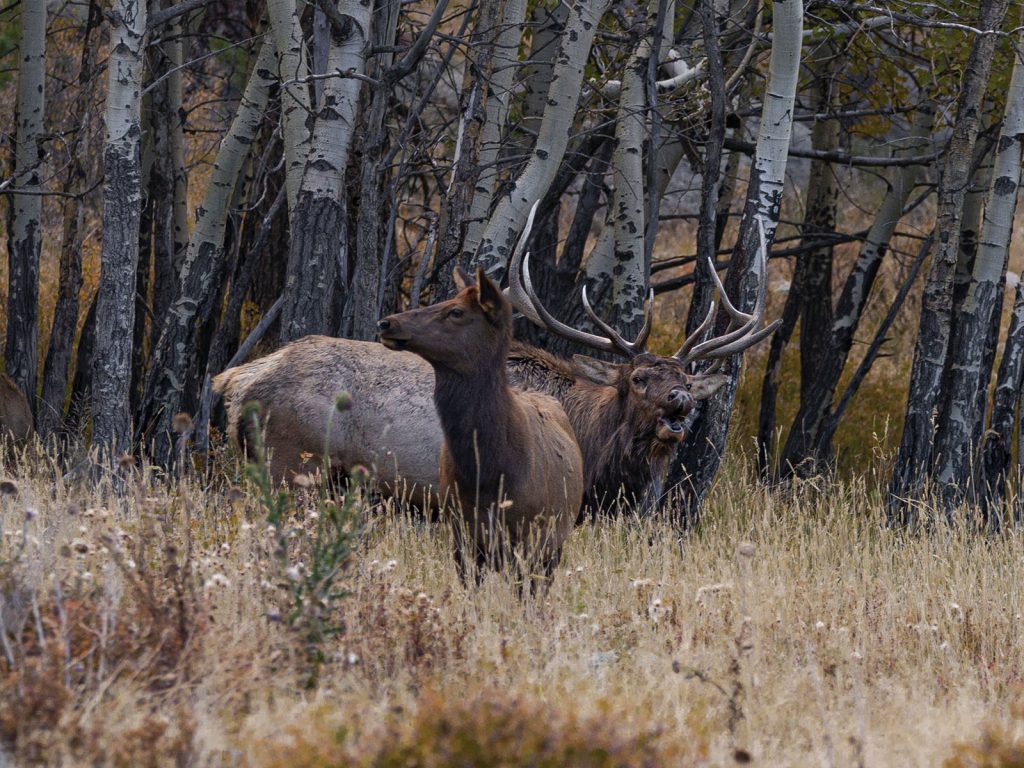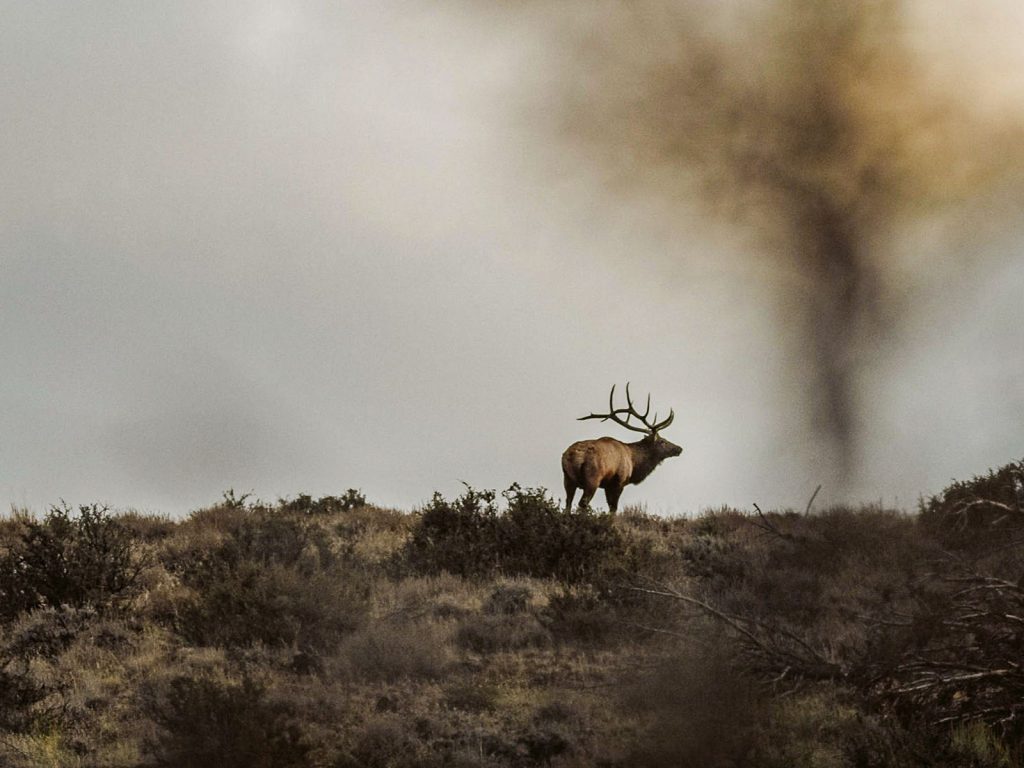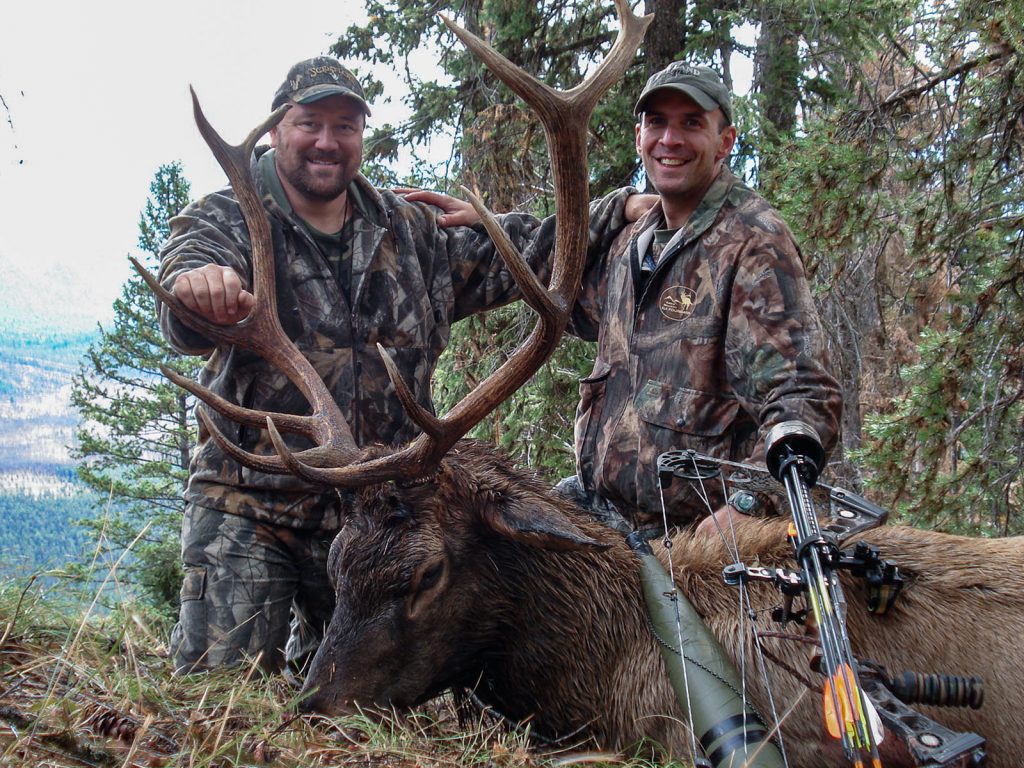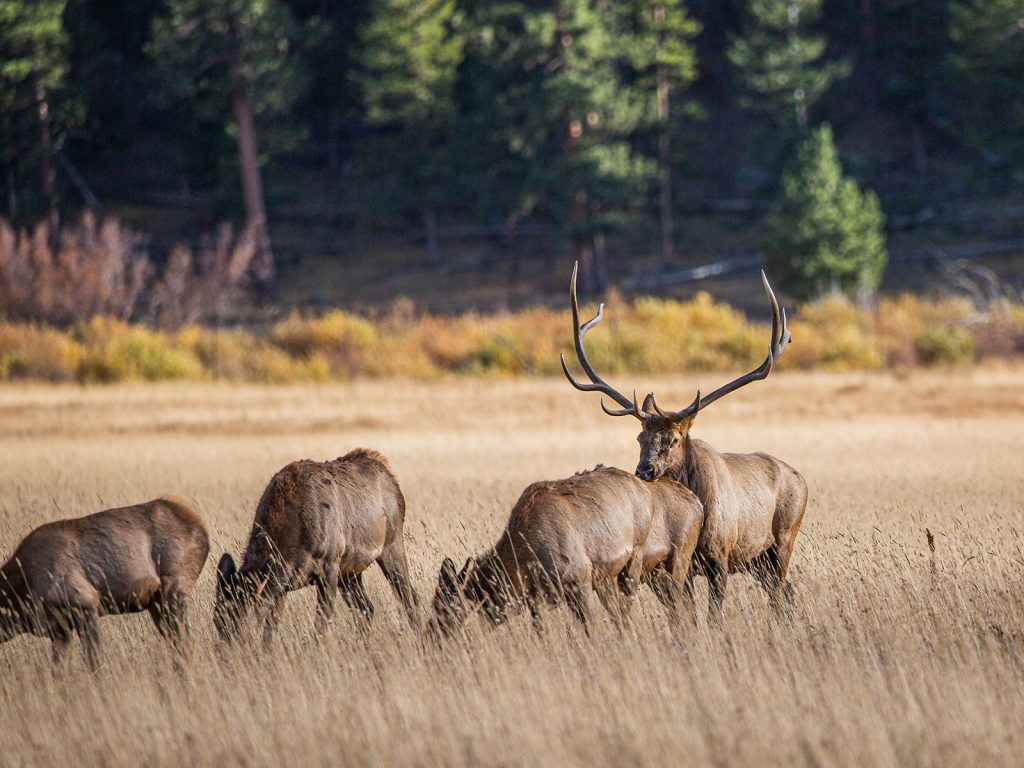
MODULE 9 - CALLING ELK
CHAPTER 1: ELK CALLING BASICS

There are many tactics that can be effective for hunting elk; treestands over water or wallows, spot and stalk, decoys, cow calling, passive calling, aggressive calling, or a combination of a few or all of these methods. A great deal of information can be found on each of these tactics, and it’s safe to say that someone, somewhere is using one of these tactics to successfully hunt elk each season. In fact, I would say that most seasoned elk hunters recognize that there isn’t any single strategy that works on every bull every day, and it’s important to be versatile and able to respond to any given situation on any given day.
I’ll admit upfront though, if there is any chance that an elk call will work to get me close to an elk, I’m going to exhaust that option before trying something else. I might even try it one or two times beyond exhaustion before resorting to another tactic, and there is a reason for that. For me, the thrill of “in your face” elk bugling has no rival in the hunting woods.
I’ve heard all the arguments about elk calls not working in heavily pressured areas, or that calls don’t work if you want to kill the really big bulls. And to some degree, those arguments certainly have some merit. But I also feel that with confidence in your calls, and with a good knowledge base of how to properly use your calls, calling can be a very effective tactic at several different times throughout the season, and on a wide demographic of elk (cows, young bulls, and mature bulls).
If you are relying solely on your calls though, as I often do, there will be several times when elk hunting can become incredibly frustrating. It’s vital to recognize when calling just isn’t working, or to recognize when it might be time to relocate to find an area – and a bull – that will be more conducive for using calls.
WHEN DO CALLS WORK?
I’m sure most hunters who have spent time calling, or trying to call elk, would agree that elk are generally most vocal during the peak of the rut – sometime around that 3rd or 4th week of September. The peak of the rut is usually directly tied to the peak of elk calling action. Leading up to the peak rut, the calling action is ramping up, and after that, the calling action is winding down. I would say using elk calls to call in elk is generally effective from the last week of August through the middle of October, give or take a week depending upon location. That means you have approximately 6 weeks to choose from when you are planning your elk hunt if you want to use calling as your primary hunting tactic. However, I’ve found that elk calling is not always equally effective during different portions of the rut, so it’s important to be prepared to adapt as needed. Sometimes, this might mean altering your calling tactics, or adding alternate tactics to your calling to supplement your efforts.
For example, in the very early phases of the pre-rut (late August/early September), the more mature bulls are likely going to be hanging out alone in their “staging” areas. They have split up from their summer bachelor groups, but they haven’t yet moved in to establish their harems and round up the cows. During this time, they will be visiting water frequently, and they will probably not be very vocal yet. So, I might rely more on location bugles to find a bull responding at first light, and then employ an ambush tactic on a waterhole or along the trail the bull is using to travel from his feeding area to his bedding area.
Similarly, during this time, the smaller bulls might already be hanging out with the herds, and might be a little more apt to be vocal. A young 5X5 or small 6X6 bull might think he is actually the herd bull for a week or two, until the bigger bulls show up and run him off. During that time, these smaller bulls can become quite vocal, and they can be susceptible to calling. I might use more of a “blind-calling” or “herd-talk” tactic with less aggression to coax these younger “herd” bulls in to my calls.

As the intensity of the rut increases (early to mid-September), the bigger bulls start spending more time closer to the cows, and the younger bulls start gaining some false confidence in their abilities to maintain control of their harems. This is my favorite time to call in elk! The big bulls don’t have cows yet, and they also don’t have much patience for another bull thinking he is the dominant bull in the area. The younger bulls have a natural urge to fight for the cows they’ve been hanging out with for the past few weeks, and they haven’t been whipped by the bigger bulls yet. This creates a perfect recipe for several bulls to be very responsive to calls.
Once the peak rut kicks in (mid to late September), and the bigger bulls have taken control of the herds, the bugling action can be insane. However, the effectiveness of calling the herd bulls in using calls decreases, as the herd bulls are focused on one thing – breeding their cows. If you can convince a herd bull that you are a cow that is ready to be bred, or, if you can get close enough to issue an effective challenge, you might be able to get his attention. Otherwise, you might simply hear 100 bugles every morning but never really get close to the bull. During this phase, the younger bulls will sometimes come in more readily, hoping to find an equal opponent to battle for the cows, or hoping to steal a cow away from a pre-occupied herd bull.
Then, as the rut winds down (early to mid-October), the bulls will still call sporadically, but they won’t usually be as aggressive or as willing to come running to the calls. However, during this phase, calls can still be an effective way to locate elk, and then use other methods for getting in close for a shot. By this time, rifle seasons are usually starting to open, so simply locating an elk at daylight can be very helpful in pinpointing a bull and then slipping in close enough for a shot.
As you can see, there are many dynamic factors that take place throughout the different phases of the rut, and those factors all play a part in the effectiveness of using elk calls. And just as there are several tactics outside of elk calling for hunting elk, there are several tactics within elk calling that can be effective: timid calling, aggressive calling, frequent calling, occasional calling, cow calling, bugling, herd calling, and the list goes on.
The very fact that there are so many options and tactics for calling elk can be overwhelming for an elk hunter, and it can make it difficult to find the confidence you need to rely on your calls. If you throw in the arguments that you can’t use bugles to call in big bulls, or you will scare away smaller bulls if you are aggressive, you might think it’s pointless to even use calls. But I’m here to tell you, it’s not pointless, and it doesn’t have to be intimidating or overwhelming. Let me break it down into a very easy to understand concept.
LANGUAGE VS. EMOTION
I was fortunate to spend my childhood growing up in the heart of elk country. This fact doesn’t necessarily mean that elk hunting came naturally to me though. In fact, it could be argued that I was a very slow learner and it took me several years to realize that I would need to become a better student if I wanted to achieve any kind of consistent success.
I remember very well one of the first times an elk hunting lesson was driven into my mind. I was a sophomore in college and returned home every weekend to squeeze in a day or two of elk hunting. With my dad guiding elk hunters in another state, I grabbed my video camera, bow, and bugle tube, and headed out for a solo, Friday evening hunt. Hiking into a clearcut where I had found elk in the past, it didn’t take long to hear the familiar sounds of bugles coming out of the thick timber surrounding the basin. I slowly and quietly slipped up to the edge of the clear cut and set up the video camera.

I let out my initial bugle; a perfect-pitched, beautiful bugle that I was certain would convince even the wisest of elk that I was one of them. After a couple of minutes, I got a response. This pattern was repeated for 5-6 minutes until I could see a nice 6X6 bull walking along the edge of the clearcut, 500 yards away. Being able to now visually catch the action on video, I zoomed in on the bull before letting out the most perfect bugle I could create. I’ll admit, I was a little offended when he didn’t even lift his head to look in my direction, and for a moment, I wished I hadn’t already turned the camera on.
The bull continued feeding on the green grass that was growing alongside the skid road, and after a minute or two of silence, he paused to let out a bugle of his own. I waited the standard 90 seconds, then followed up with another perfect staircase of elk calling octaves.
This “conversation” continued for 20 minutes before the bull slowly dropped off the backside of the ridge and made his way back into the timbered basin he had emerged from. I was dumbfounded. Everything was perfect. It was mid-September, I had found a big bull all by himself, I had bugled as well as I could bugle, yet the bull didn’t even lift his head to look in my direction.
When my dad returned home from guiding a couple weeks later, I was anxious to show him the video of this great bull I had almost called in. My season had ended unsuccessfully, but I was still hoping to hear a congratulatory expression of “great job” or “wow, he is a big bull”. Instead, my dad chuckled and asked, “Why didn’t you call him in?”
What? He could hear as plainly as I could that I had given the bull some of the most beautiful bugles I could muster, and for some reason unknown to me, the bull was just ignoring me. It was a textbook calling sequence with one exception – the bull never came in. In fact, the bull never really expressed interest or acknowledged my presence. As I started to point out the obvious fact that I was trying to call the bull in, my dad taught me a lesson I have never forgotten. He said, “If you want a bull to come in, you have to give him a reason to come in.” Plain and simple. Bugling to a bull with pretty bugles might work once in a while, but don’t count on it. You have to give him a reason to come in.
I thought about that advice many times over the next several elk seasons and the conclusion I came to has become the foundation for my hunting strategy today. There are two primary reasons why a bull would want to come in to calls: to check out a cow or to fight another bull. If I’m going to repeatedly have elk standing within bow range, I need to figure out how to convince them that there is an opportunity – and a reason – to do one of those two things.
There has been a lot written and said over the last 30+ years about the language an elk speaks. Some hunters have cracked the code of an elk’s language, and have enjoyed consistent success in recognizing what the elk is saying, and then saying the right thing back to the bull to convince him to come in. There is an entire vocabulary created by elk hunters that attempt to describe every sound an elk makes, and there are multiple definitions of what each of those sounds really mean. And while I am in no way belittling that strategy or the success of hunters who employ that strategy, I feel the root of calling in elk is much more simple. In fact, I don’t feel that elk have a “language” at all. I feel that elk communicate simply through emotion. And the two emotions that elk respond to during the rut are the desire to breed and the desire to fight.
Again, my philosophy on elk calling differs from many other very successful elk hunters, and I would never question their tactics or their success. But learning multiple different calls and then remembering which call to give in return in which situation becomes very confusing for my simple mind. I need a strategy that works in multiple situations, and without a lot of opportunity for me to mess it up. And when I boil down all the situations where I’ve been able to call elk in, I’ve recognized there is a common link – emotion.
Fast forwarding a few years from that big bull in the clearcut – I was enjoying more consistent success, but still a young student in the game of elk hunting. It was 11:00 a.m., and my hunting partner and I had located a bull across the canyon that was bugling from his bed on a thick, north-facing bench. With the midday rain creating virtually silent stalking conditions, we decided to hike across the canyon and get as close to the bull as we could before we announced our approach. Once we made it to the other side of the canyon, we lost the landmarks we had pinpointed initially, and weren’t sure of the bulls exact location. We found a nice saddle on a finger ridge somewhere below the bench the bull had been bugling from and set up.

I moved back 30 yards and as I let out a soft cow call to warm up my diaphragm, still unsure of exactly where we were in relation to where we had heard the bull, the bull responded immediately with a weak bugle. He was bedded just 100 yards up the hill from us, and I was caught a little bit off-guard. Filled with a mix of adrenaline and desperation, my responding bugle came out a bit shrill and rushed. Dry pine needles crunched as the bull stood in his bed, and the crashing branches left no doubt this bull was heading our way in a hurry. Less than a minute later, we were walking up on a nice 5X6 bull that had traveled less than 30 yards after my partner’s seven-yard, broadside shot.
Something clicked in my mind as we spent the rest of the day packing heavy loads of elk meat back to the truck. Council I received in my youth from my mom came clearly into my mind: “It’s not what you say that gets you in trouble. It’s the way you say it.” She likely wasn’t trying to give me coded lessons in elk hunting when she taught me this, but, similar to the responses that prompted her to tell me this repeatedly, my bugle to that bull had been rushed and filled with emotion. The way I unintentionally responded to him made him come unglued, and without thinking, he came storming in, guard down, looking for a fight. It wasn’t the fact that I simply bugled to him that got him headed our way. It was the way I bugled to him.
With a calling strategy that involves just two basic emotions, I truly feel that I have all my bases covered for just about any situation I face throughout the 6+ weeks that elk are responding to calls. In no way am I saying it is foolproof or guaranteed to work every time, but it is the most effective way I’ve found to call elk in on a consistent basis, regardless of the multiple factors that continually change throughout the season.
Within this strategy, there are still a few variables that are worth exploring: specifically, how aggressive should you be, and should you use cow calls or bugles.
AGGRESSION VS. TIMID CALLING
At this point in the discussion, it’s important to recognize the attitude of the elk you are calling to. His attitude is often times going to dictate how aggressive you should be, or whether he is going to be more interested in breeding or fighting. A young bull in the middle of the season might have just been chased away from the herd by a mature bull, and the young bull might be very lonely for companionship. A single cow call might be all that it takes to get him running your direction, where an aggressive bugle might be a harsh reminder of the whipping he just took the day before.

Or, a herd bull in late September might not be too concerned with a mouthy, aggressive bull up on the ridge, but a cow elk announcing that she is ready to be bred might make him forget about everything else and come in on a run. Recognizing the bull’s attitude and demeanor will be important as you decide how aggressive you should be – and which emotion you need to play to – with your calls.
For the most part, I like to start out timid, which means trying to elicit a response through the bull’s emotion to breed – i.e., cow calls. If the bull gets worked up over a simple cow call, that makes the calling sequence really easy. However, if I was to start out with an aggressive, challenging bugle – i.e, trying to trigger the bull’s emotion to fight – it would be difficult to switch gears and try to use timid calls to then trigger his desire to breed. If I open the door to aggression and I can’t convince the bull to fight, it’s going to be difficult to convince him to come in to a timid call immediately after. However, if I start timid and can’t trigger an emotional response with cow calls, I can easily escalate the intensity and get aggressive.
Although I always start with a more timid approach (cow calls), I personally prefer the fight scenario. Cow calling is incredibly effective, and if a bull is responding and coming in to just cow calls, that is what I will keep giving him. There is no reason to take a chance of “scaring” him away with aggression if there is no need to use it. However, I’ve found that bulls will often come in “searching”, with their guard up and senses on full alert, when responding to cow calls. Additionally, a bull knows a cow is as desperate to be bred as he is to breed her, so it is not uncommon for a bull to stand his ground and continue bugling in an attempt to get the cow to come to him.
During the rut, testosterone is raging through the bulls as they prepare to breed. They have very short fuses, and when that fuse gets lit, they often respond very quickly and very aggressively. Getting a bull “fighting mad”- with his eyes rolled back in his head and slobbering all over himself – is not only an incredible rush, it is also a great way to get the bull to drop his guard and come running in to a setup without stopping to listen to what his senses might otherwise be saying to him.
With this overview of using emotions to call elk, I’m excited to share with you the calling tactic that I use 90% of the time to elicit an emotional response and call in elk. If you’re ready to learn how I approach every elk calling situation, Click ‘Next Chapter’ Below to Continue to Chapter 2: My Go-to Elk Calling Sequence





